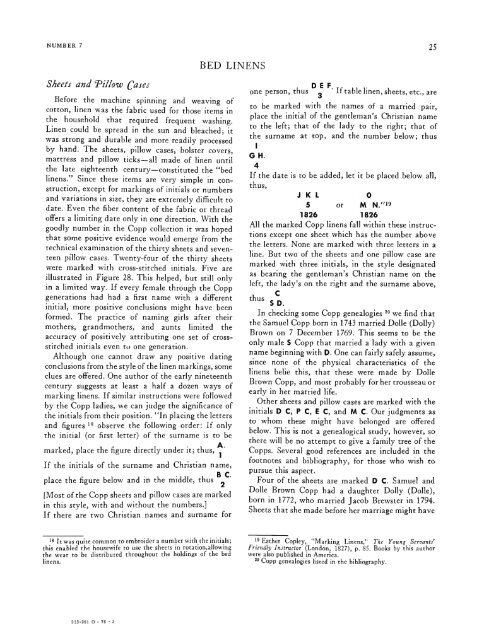The Copp Family Textiles - Smithsonian Institution Libraries
The Copp Family Textiles - Smithsonian Institution Libraries
The Copp Family Textiles - Smithsonian Institution Libraries
Create successful ePaper yourself
Turn your PDF publications into a flip-book with our unique Google optimized e-Paper software.
NUMBER 7 25<br />
Sheets and billow Qases<br />
BED LINENS<br />
Before the machine spinning and weaving of<br />
cotton, linen was the fabric used for those items in<br />
the household that required frequent washing.<br />
Linen could be spread in the sun and bleached; it<br />
was strong and durable and more readily processed<br />
by hand. <strong>The</strong> sheets, pillow cases, bolster covers,<br />
mattress and pillow ticks—all made of linen until<br />
the late eighteenth century—constituted the "bed<br />
linens." Since these items are very simple in construction,<br />
except for markings of initials or numbers<br />
and variations in size, they are extremely difficult to<br />
date. Even the fiber content of the fabric or thread<br />
offers a limiting date only in one direction. With the<br />
goodly number in the <strong>Copp</strong> collection it was hoped<br />
that some positive evidence would emerge from the<br />
technical examination of the thirty sheets and seventeen<br />
pillow cases. Twenty-four of the thirty sheets<br />
were marked with cross-stitched initials. Five are<br />
illustrated in Figure 28. This helped, but still only<br />
in a limited way. If every female through the <strong>Copp</strong><br />
generations had had a first name with a different<br />
initial, more positive conclusions might have been<br />
formed. <strong>The</strong> practice of naming girls after their<br />
mothers, grandmothers, and aunts limited the<br />
accuracy of positively attributing one set of crossstitched<br />
initials even to one generation.<br />
Although one cannot draw any positive dating<br />
conclusions from the style of the linen markings, some<br />
clues are offered. One author of the early nineteenth<br />
century suggests at least a half a dozen ways of<br />
marking linens. If similar instructions were followed<br />
by the <strong>Copp</strong> ladies, we can judge the significance of<br />
the initials from their position. "In placing the letters<br />
and figures 18 observe the following order: If only<br />
the initial (or first letter) of the surname is to be<br />
marked, place the figure directly under it; thus,<br />
If the initials of the surname and Christian name,<br />
B C<br />
place the figure below and in the middle, thus<br />
[Most of the <strong>Copp</strong> sheets and pillow cases are marked<br />
in this style, with and without the numbers.]<br />
If there are two Christian names and surname for<br />
18 It was quite common to embroider a number with the initials;<br />
this enabled the housewife to use the sheets in rotation,allowing<br />
the wear to be distributed throughout the holdings of the bed<br />
linens.<br />
213-261 O - 76<br />
one person, thus D E F. If table linen, sheets, etc., are<br />
to be marked with the names of a married pair,<br />
place the initial of the gentleman's Christian name<br />
to the left; that of the lady to the right; that of<br />
the surname at top, and the number below; thus<br />
I<br />
GH.<br />
4<br />
If the date is to be added, let it be placed below all,<br />
thus,<br />
J K L 0<br />
5 or M N."W<br />
1826 1826<br />
All the marked <strong>Copp</strong> linens fall within these instructions<br />
except one sheet which has the number above<br />
the letters. None are marked with three letters in a<br />
line. But two of the sheets and one pillow case are<br />
marked with three initials, in the style designated<br />
as bearing the gentleman's Christian name on the<br />
left, the lady's on the right and the surname above,<br />
thus<br />
C<br />
SD.<br />
In checking some <strong>Copp</strong> genealogies 20 we find that<br />
the Samuel <strong>Copp</strong> born in 1743 married Dolle (Dolly)<br />
Brown on 7 December 1769. This seems to be the<br />
only male S <strong>Copp</strong> that married a lady with a given<br />
name beginning with D. One can fairly safely assume,<br />
since none of the physical characteristics of the<br />
linens belie this, that these were made by Dolle<br />
Brown <strong>Copp</strong>, and most probably for her trousseau or<br />
early in her married life.<br />
Other sheets and pillow cases are marked with the<br />
initials D C, P C, E C, and M C. Our judgments as<br />
to whom these might have belonged are offered<br />
below. This is not a genealogical study, however, so<br />
there will be no attempt to give a family tree of the<br />
<strong>Copp</strong>s. Several good references are included in the<br />
footnotes and bibliography, for those who wish to<br />
pursue this aspect.<br />
Four of the sheets are marked D C. Samuel and<br />
Dolle Brown <strong>Copp</strong> had a daughter Dolly (Dolle),<br />
born in 1772, who married Jacob Brewster in 1794.<br />
Sheets that she made before her marriage might have<br />
19 Esther Copley, "Marking Linens,'' <strong>The</strong> Young Servants'<br />
Friendly Instructor (London, 1827), p. 85. Books by this author<br />
were also published in America.<br />
20 <strong>Copp</strong> genealogies listed in the bibliography.

















